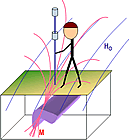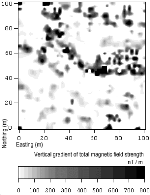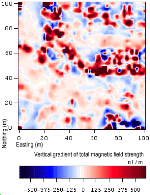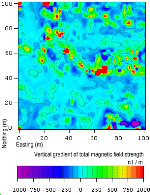 Introduction Introduction
Most modern total magnetic field strength instruments are capable
of collecting data using two sensors, thus permitting the gradient in one direction
to be recorded. The vertical gradient of total magnetic field strength is measured
using two sensors at (typically) 2 and 3 metres above the ground. Horizontal
gradient surveys can be conducted if the sensors can be mounted one meter apart
on a frame.
Buried objects under industrial sites often have high magnetic susceptibility,
resulting in strong induced secondary magnetic fields oriented in the same direction
as the incident field. Such objects also frequently have strong remanent magnetization,
with the remanent field oriented in an arbitrary direction. Of course it should be remembered that some targets
will be metallic but not ferrous (such as aluminum and some forms of stainless
steel). Such targets may have no magnetic signature at all.
Survey Design
When searching for buried objects, simple anomaly detection is
often adequate. Rapid acquisition of spatially dense data sets is usually
required, and results are often presented with a minimum of processing. Because
of the many ferrous objects and electrical sources of magnetic fields under and
around industrial sites, ordinary total-field anomaly maps may be too complicated
to interpret, or subtle variations may be swamped by larger features. A gradient
survey is often a better choice because the magnetic field gradient varies more
rapidly than total field strength and it therefore provides higher spatial resolution. Also, temporal variations are automatically eliminated, so the base station measurements
and subsequent data corrections are not required.
Data provided
For this project, the data were gathered prior to all the other geophysical work in order
to locate subsurface magnetic sources such as steel underground storage tanks
or pipes that could be potential sources of oil. Data were acquired on a
regular 2 m grid, and the complete data set is available in the file maggrad.xls. Results are presented in the following three figures each of which shows identical raw unprocessed
gradient data; only their colour scales are different. Click on each figure for a large version.
- If only black and white contours are to be used, negative
gradients will be suppressed. This may in fact simplify the image, but some features may also be hidden.
- Use of two colours helps to identify characteristics of
data that are essentially bimodal.
- The rainbow colour scale is usually the most reliable but the colour scale should be choosen carefully so that zones of uniform colour do not hide important details. The addition of contour lines helps with display of subtle variations.
Finally, please note that interpretation can be easier if animation is used to
facilitate comparison between data sets that cover identical areas. We provide
one page that allows the user to select static images,
and a second page which allows the user to view "flicker" animations of pairs of data sets.
|




